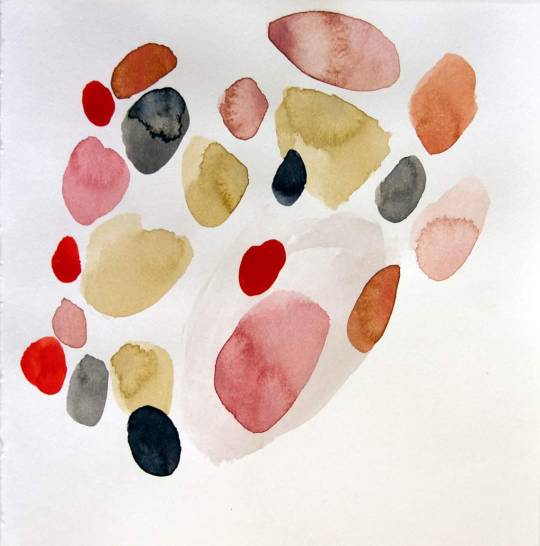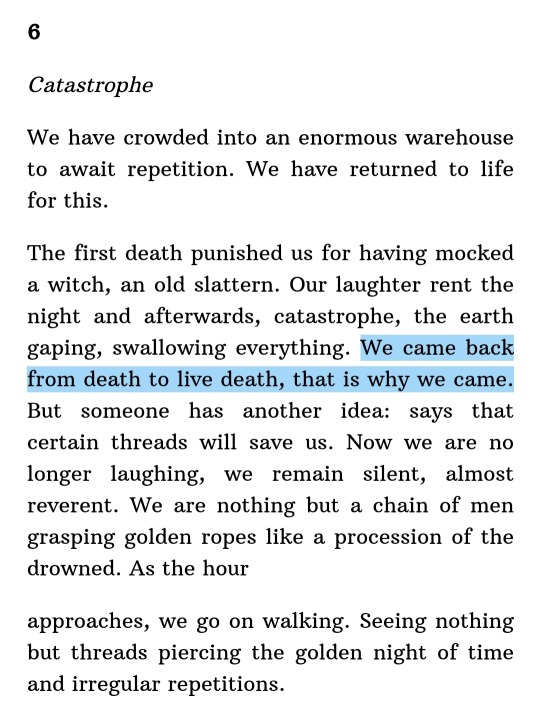#maria negroni
Text
Is there a violence sadder than the word island?
— Islandia, Maria Negroni
1 note
·
View note
Text










An evening out in Rome.
First cocktails on the rooftop bar and watching the sunset on the Sta Maria Maggiore across the street. I ordered a Tatma Negroni, which turned out to be a flight. The first was Tamarind, the second was hazelnut, the third was coffee.
Then to Trieste pizza for some truly amazing pizza. Burrata and crudo.
Finally a gelato and chocolate to go for my beloved.
Back to air conditioning at the hotel!
22 notes
·
View notes
Text
Lo dijo la filósofa Maria Zambrano: escribir es defender el silencio en que se está.
“El corazón del daño” de María Negroni
7 notes
·
View notes
Video
Maria Jacobini in Beatrice Cenci (1926) by Truus, Bob & Jan too!
Via Flickr:
Italian postcard by G.B. Falci Ed. for Unica - Ciocolato Talmone al latte. Photo: Pittaluga Film. Maria Jacobini in Beatrice Cenci (Baldassarre Negroni, 1926). Among the Italian divas, Maria Jacobini (1892-1944) was an island of serenity, as Vittorio Martinelli expressed it, the personification of goodness, of simple love. Her weapon was her sweet and gracious smile. However, in some Italian and later German films, she could also play the vivacious lady, the femme fatale, the comedienne, the hysterical victim, and the suffering mother or wife. Maria Jacobini was born in Rome, Italy, in 1892. She was the sister of actress Diomira Jacobini. Their older sister Bianca had also started as an actress but had interrupted her career after four films. Maria studied at the Accademia di Arte Drammatica di S. Cecilia, where her teachers were Virginia Marini and Eduardo Boutet. She made her stage debut at the company of Cesare Dondini Jr., where she mainly played secondary parts. She was noticed by Ugo Falena, artistic director of the film company Film d'Arte Italiana. He offered her work in the silent cinema. Her first short films were Lucrezia Borgia/Lucretia Borgia (Ugo Falena, 1910) featuring diva Francesca Bertini, and Beatrice Cenci (Ugo Falena, 1910), but her first important role was in Cesare Borgia (Gerolamo Lo Savio, 1912) again starring Bertini. In 1912, Maria started to work at the Savoia company of Turin, as a seductive man-eater in short films like Pantera/Panther (1912), La zingara/The gypsy (Sandro Camasio, 1912), and L'onta nascosta/The hidden shame (1912). From 1913 on, she played her more dramatic roles as the lead in Giovanna d'Arco/Joan of Arc (Ubaldo Maria del Colle, 1913) and Ananke (Nino Oxilia, 1915) with Leda Gys and her sister Diomira Jacobini. Jacobini worked for pioneering film studios like Pasquali and Celio. Maria gave good performances in the melancholic Come le foglie/Like the Leaves (Gennaro Righelli, 1916) based on Giuseppe Giacosa's stage play, and in the touching Addio Giovinezza/Good-bye Youth (Augusto Genina, 1918). She made a series of films with director Gennaro Righelli such as Il viaggio/The Journey (1921), based on a novel by Luigi Pirandello, and Cainà - la figlia dell'isola/Cainà - the Daughter of the Island (1923), shot in Sardinia. After the First World War, the Italian film industry was in a deep crisis, and director Gennaro Righelli and his star Maria Jacobini decided to move to Germany. In Berlin, the new centre of the European film industry, Jacobini and Righelli were enlisted by producer Jakob Karoll and they founded a separate company called Maria Jacobini GmbH. Jacobini first starred in Bohème - Künstlerliebe/Bohème - Artists Love (Gennaro Righelli, 1923), playing the tormented and suffering Mimi. Her film partner was Wilhelm Dieterle, who would later become known as Hollywood director William Dieterle. She often performed in Righelli's German films and other directors' films. Jaap Speyer directed her in Bigamie/Bigamy (1927), Robert Dinesen in Ariadne im Hoppegarten (1928) with Alfred Abel, Richard Oswald in Villa Falconieri (1928) opposite Hans Stüwe, and by Fedor Ozep in the German-Russian coproduction Der lebende Leichnam/Zhivoy trup/The Living Corpse (1929), based on the play by Leo Tolstoy. These productions were shot all over Europe, and Jacobini even filmed in Africa for Die Frauengasse von Algier/The Street of Women of Algiers (Wolfgang Hoffmann-Harnisch, 1927) with Camilla Horn. In the second half of the 1920s, Maria Jacobini performed also in a few Italian films such as La bocca chiusa/Shut up(Guglielmo Zorzi, 1925) opposite Lido Manetti a.k.a. Arnold Kent and Carmen Boni, Beatrice Cenci (Baldassarre Negroni, 1926), and Il carnevale di Venezia/The carnival of Venice (Mario Almirante, 1928). In France, she did Maman Colibri/Mother Hummingbird (Julien Duvivier, 1929) with Franz Lederer. It was her final silent film. With the coming of the sound cinema, Jacobini's roles became marginal, though she continued to play in films until her death. In 1937 she became a teacher in acting at the new Roman film academy Centro Sperimentale di Cinematografia, where she gave lessons to new stars and actresses such as Alida Valli and Clara Calamai. Her final film was La donna della montagna/The Mountain Woman (Renato Castellani, 1943) with Marina Berti. aria Jacobini died a year later, in 1944 in Rome. She was 52. Sources: Vittorio Martinelli (Le dive del silenzio), Caterina Cerra (Treccani - Italian), Wikipedia (English and Italian) and IMDb. And, please check out our blog European Film Star Postcards.
1 note
·
View note
Link
0 notes
Text
MEET MY OC's!
Part 1, Part 2: Big Bitch Brigade, Part 3, Part 4
Apps used Artbreeder, Reface, and FaceApp
Nathan (Nate) E. Banks


{Not a fan of how Reface white washed him ngl}
Age: 36
Birthday: May 8th
MBTI: ENTJ-A
Alignment: Neutral Good
HH: Hufflepuff
✨Bi Wife Energy✨, married to Yelena the lucky bastard
Token Straight
He/Him
Height: 195.1 cm (6'4)
Favorite Color(s): Teal
Favorite Food: French Onion Soup
Favorite Drink: Pomegranate Juice
Favorite Music Genre: Country
Style Choice: He cold
Hobbies: Crocheting, Construction, D&D, DJing, 3D Printing
QUOTE:
Maria (Mimi) G. King



Age: 31
Birthday: January 15th
MBTI: ISTJ-A
Alignment: Chaotic Neutral
HH: Ravenclaw
Stronk; if I die by their hands do not prosecute them! They caught me slippin'
She/They
Aro-ace
Height: 182.88 cm (6'0)
Favorite Color(s): Orange, Gold
Favorite Food: Quiche
Favorite Drink: Vanilla Vodka Chai
Favorite Music Genre: Bollywood Pop
Style Choice: Business but make it ✨Athletic✨
Hobbies: Cosplaying, Binge Watching, Chess, Book Restoration
Quote: If you want to simp, you have to pay the pimp. *Directed at Nate
Yelena (Lanie) C. King-Banks



Age: 30
Birthday: December 18th
MBTI: ISFJ-T
Alignment: Lawful Good
HH: Slytherin
I have made her look meaner than her sister, this is not the case
She/Her
Bisexual
Height: 207.3 cm (6'8)
Favorite Color(s): Violet
Favorite Food: Shepherds Pie
Favorite Drink: Mojito (originally it was negroni, by itself, but I didn't post this before HotD aired)
Favorite Music Genre: Reggaeton
Style Choice: Eternal Summer
Hobbies: Bullet Journaling, Astronomy, Blacksmithing, D&D
Quote: They go low, I go to hell. Don't try me.
0 notes
Photo

María Negroni, Night Journey (tr. Anne Twitty)
35 notes
·
View notes
Text
Opinión: «La noche tiene mil ojos», María Negroni
Opinión: «La noche tiene mil ojos», María Negroni
Año de publicación: 2015Editorial: Caja NegraISBN: 978-987-1622-33-7Páginas: 352
En este volumen se reúne por vez primera la “trilogía negra” de María Negroni, compuesta por Museo Negro (1998), Galería Fantástica (2008) y el hasta ahora inédito Film Noir. Tres libros de ensayo consagrados a profundizar los alcances de la literatura gótica y su profuso imaginario, en los que Negroni propone…

View On WordPress
#billy wilder#Dashiell Hammett#film noir#fritz lang#hard boiled#libros#literatura#literatura gotica#maria negroni#metropolis#opinion#raymond chandler#reseña
2 notes
·
View notes
Text

Karina Beltrán & María Negroni
de escasa ternura esta tierra
de larga noche sus torres
de estamentos
cuya incursión propicia
acaso no veamos
y esto
sin más testigo
que pórticos
deudas de inmensa gratitud
en lo más bajo del cielo
y es otra vez la más antigua
de todas las cosas
el bien del mal
buscando abrigo en lo inhóspito
como si fuera un desvelado ruiseñor
y he aquí que se yergue
en la canción vencida
y se dirige
al colmo de la sombra y clama
por alcanzar el sentido
………—no el nombre—
de la voz carnal
y después cae
y se levanta
y vuelve a caer
radiante en sus harapos
y lo que sigue es una fiesta
de perspectivas más que humanas
—porque caer es una gracia—
- María Negroni, de Oratorio
- Karina Beltrán. Leer la piel-19. 2013. Acuarela sobre papel.
15 notes
·
View notes
Text
"Esa noche, como todas las noches, la niña soñó que había nacido huérfana y que esa condición –si así puede llamársele– la empujaba a un mundo adentro del mundo que se parecía a un hermoso circo, lleno de domadores de tigres, contorsionistas, lanzadores de fuego. A ella le había tocado la Muerte-en-Vida. Su número consistía en balancearse sobre una cuerda pero ella se enredaba en el pelo e indefectiblemente daba un salto mortal a lo imposible. La caída se repetía tres veces, sin motivo aparente y, lo que es peor, sin destinatario. El amor es un arte antiguo, imposible, feroz."
• María Negroni, Elegía a Joseph Cornell
• Funambulista, 1890.

36 notes
·
View notes
Quote
True, Gothic castles are, by definition, outmoded. But at the same time, and no doubt for that very reason, their architecture of excess houses the sutured dreams, shadowy ossuaries, that disclose the muffled zones of human experience, granting access to hallucinatory knowledge.
María Negroni, Dark Museum.
282 notes
·
View notes
Text
“Nemo. The name means Nobody— just as Ulysses designated himself when Polyhemus asked him who he was. He wanted to establish, perhaps, that he was a traveler, something like a hero of the ancient, an Argonaut willing to face the trials that dispossession lay before him. Because Nemo is also an anagram, Omen: all the doom encrypted in presages of humanity.”
— María Negroni, from Dark Museum (tr. Michelle Gil-Montero)
#Maria Negroni#Dark Museum#analysis#Jules Verne#twenty thousand leagues under the sea#the Gothic#names#x#favourite#María Negroni
45 notes
·
View notes
Text
What if time were lawless?
Where do you keep what wasn’t?
They go on like this and that
you never know what kills you
and January sun and you just came
just like a breath and worked me
to confine my body’s surrounds
to the exacting beauty of lack.
María Negroni
From the collection Riddance (Original Spanish title: Andanza)
#poetry#not mine#maria negroni#this was perfect on a dark and stormy night#new moon magic#synchronicity
6 notes
·
View notes




